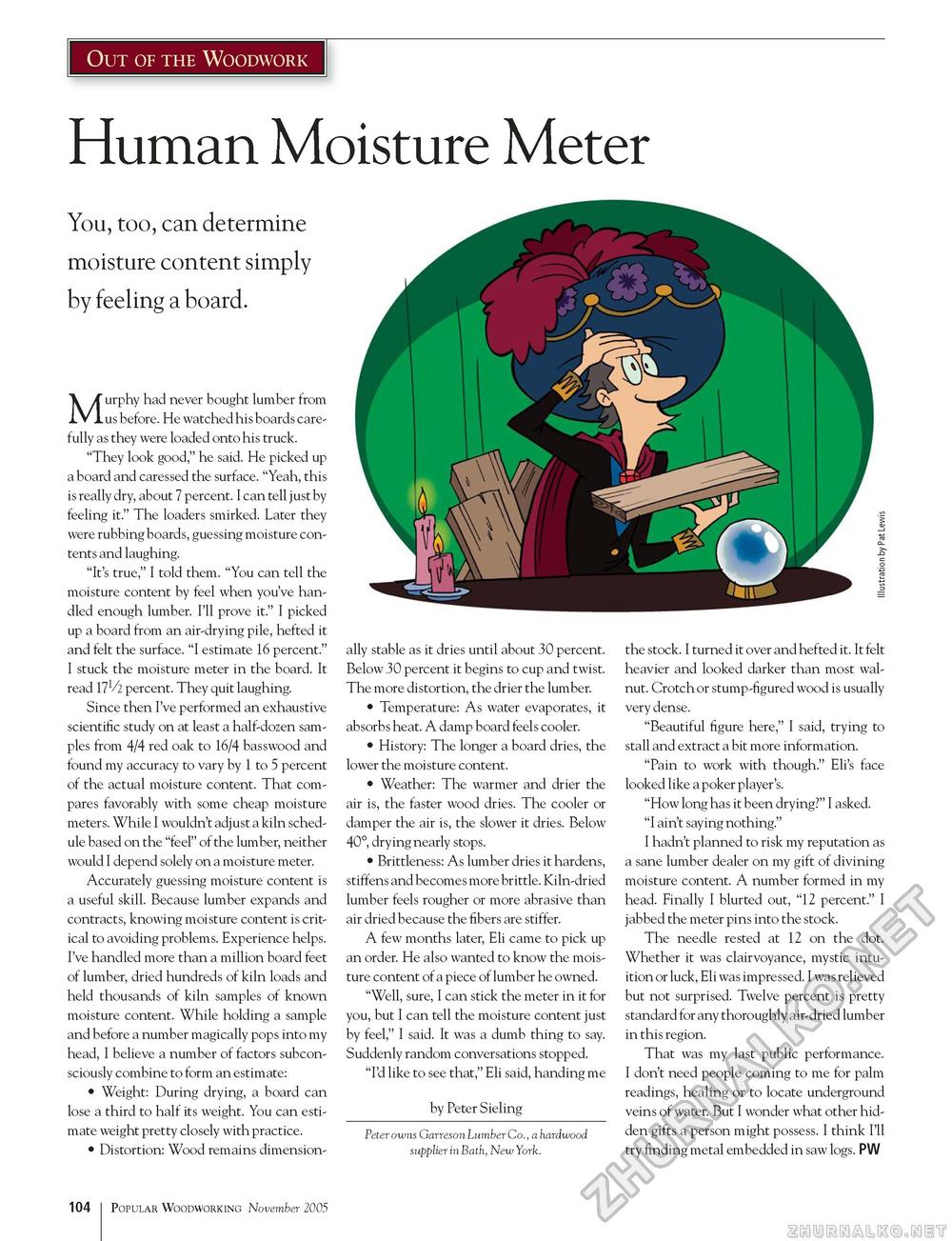Popular Woodworking 2005-11 № 151, страница 107
Out of the Woodwork Human Moisture Meter You, too, can determine moisture content simply by feeling a board. Murphy had never bought lumber from us before. He watched his boards carefully as they were loaded onto his truck. "They look good," he said. He picked up a board and caressed the surface. "Yeah, this is really dry, about 7 percent. I can tell just by feeling it." The loaders smirked. Later they were rubbing boards, guessing moisture contents and laughing. "It's true," I told them. "You can tell the moisture content by feel when you've handled enough lumber. I'll prove it." I picked up a board from an air-drying pile, hefted it and felt the surface. "I estimate 16 percent." I stuck the moisture meter in the board. It read 17^'/2 percent. They quit laughing. Since then I've performed an exhaustive scientific study on at least a half-dozen samples from 4/4 red oak to 16/4 basswood and found my accuracy to vary by 1 to 5 percent of the actual moisture content. That compares favorably with some cheap moisture meters. While I wouldn't adjust a kiln schedule based on the "feel" of the lumber, neither would I depend solely on a moisture meter. Accurately guessing moisture content is a useful skill. Because lumber expands and contracts, knowing moisture content is critical to avoiding problems. Experience helps. I've handled more than a million board feet of lumber, dried hundreds of kiln loads and held thousands of kiln samples of known moisture content. While holding a sample and before a number magically pops into my head, I believe a number of factors subconsciously combine to form an estimate: • Weight: During drying, a board can lose a third to half its weight. You can estimate weight pretty closely with practice. • Distortion: Wood remains dimension- ally stable as it dries until about 30 percent. Below 30 percent it begins to cup and twist. The more distortion, the drier the lumber. • Temperature: As water evaporates, it absorbs heat. A damp board feels cooler. • History: The longer a board dries, the lower the moisture content. • Weather: The warmer and drier the air is, the faster wood dries. The cooler or damper the air is, the slower it dries. Below 40°, drying nearly stops. • Brittleness: As lumber dries it hardens, stiffens and becomes more brittle. Kiln-dried lumber feels rougher or more abrasive than air dried because the fibers are stiffer. A few months later, Eli came to pick up an order. He also wanted to know the moisture content of a piece of lumber he owned. "Well, sure, I can stick the meter in it for you, but I can tell the moisture content just by feel," I said. It was a dumb thing to say. Suddenly random conversations stopped. "I'd like to see that," Eli said, handing me by Peter Sieling Peter owns Garreson Lumber Co., a hardwood supplier in Bath, New York. the stock. I turned it over and hefted it. It felt heavier and looked darker than most walnut. Crotch or stump-figured wood is usually very dense. "Beautiful figure here," I said, trying to stall and extract a bit more information. "Pain to work with though." Eli's face looked like a poker player's. "How long has it been drying?" I asked. "I ain't saying nothing." I hadn't planned to risk my reputation as a sane lumber dealer on my gift of divining moisture content. A number formed in my head. Finally I blurted out, "12 percent." I jabbed the meter pins into the stock. The needle rested at 12 on the dot. Whether it was clairvoyance, mystic intuition or luck, Eli was impressed. I was relieved but not surprised. Twelve percent is pretty standard for any thoroughly air-dried lumber in this region. That was my last public performance. I don't need people coming to me for palm readings, healing or to locate underground veins of water. But I wonder what other hidden gifts a person might possess. I think I'll try finding metal embedded in saw logs. PW 104 Popular Woodworking November 2005 |







